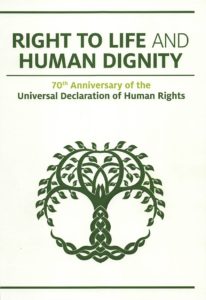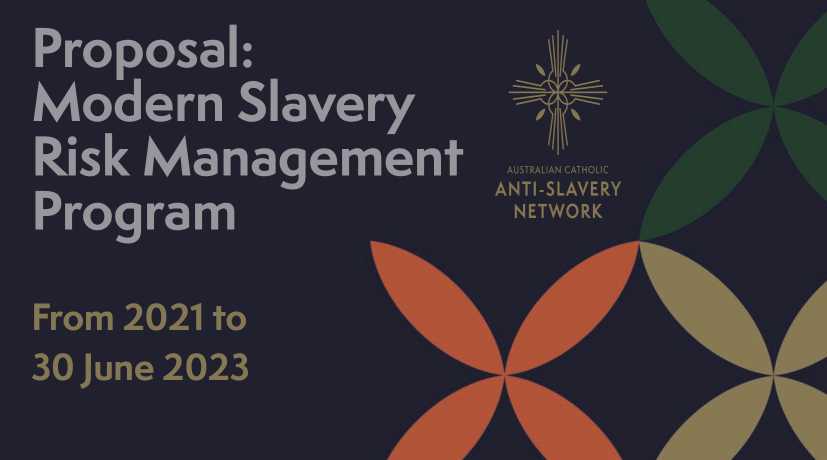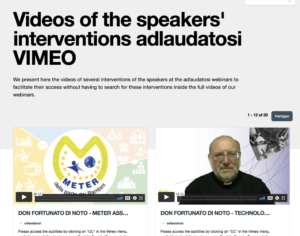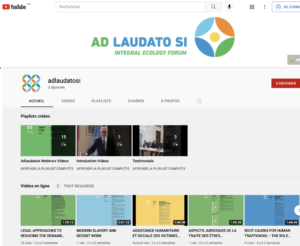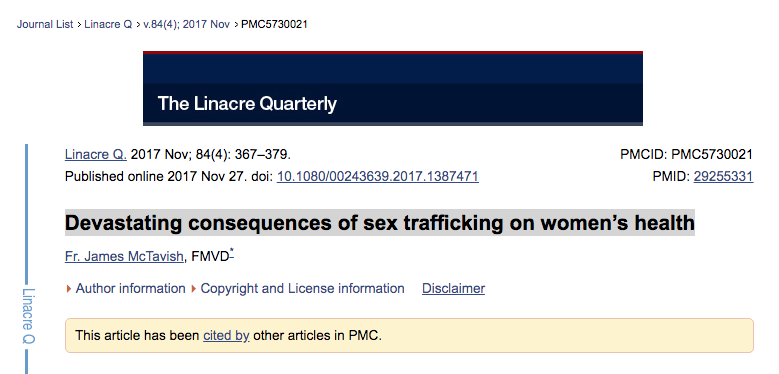
Click on the image above to be directed to Fr McTavish’s article
Devastating consequences of sex trafficking on women’s health
On the first of November, I celebrated the Holy Mass of All the Saints at a center for rehabilitation of female survivors of sex trafficking. They are being taken care of by Religious Sisters who have a specific dedication in this area.1 The Sister in charge commented to me that same-sex attraction (SSA) was commonly observed among such girls, including sexualized behavior with the same sex. I was asked how we should consider this phenomenon of SSA in this context and how best to help these young victims. The experience of visiting the shelter made me reflect on the health consequences—physical, mental, and spiritual—of the traumatic experience these girls have been through.
I would like to answer this pastoral question of female SSA, post-sex trafficking by first looking at the broader picture of human trafficking for sexual purposes and briefly showing its devastating impact on women’s health globally. Next, I will share some specific points of Catholic moral teaching on prostitution and human trafficking before considering the specific role of healthcare workers in identifying and assisting victims of trafficking. The Religious Sisters’ general approach in ministering to the victims of sex trafficking and prostitution will then be outlined, before closing with some pastoral considerations regarding the experience of SSA in this specific context.
Human Trafficking
Earlier this year Archbishop Bernardito Auza delivered a lecture titled “The Holy See and the Fight Against Human Trafficking” (Auza 2017). He estimated that thirty-six million people were trafficked in 2016. Archbishop Auza stated that:
according to the 2016 Global Report on Trafficking in Persons released two months ago by the UN Office on Drugs and Crime, human trafficking is a 32 billion dollar industry, running third behind arms and drug trafficking. Fifty-one percent of the victims are women, 21 percent are men, 20 percent girls and 8 percent boys. (Auza 2017)
For women victims of trafficking, 72 percent of them are trafficked for sexual exploitation. This would mean that globally approximately 13 million women are sex trafficked annually.
The “Trafficking in Persons Report” (TIP report) released by the U.S. Department of State explains “‘Trafficking in persons’ and ‘human trafficking’ have been used as umbrella terms for the act of recruiting, harboring, transporting, providing, or obtaining a person for compelled labor or commercial sex acts through the use of force, fraud, or coercion” (U.S. Department of State 2016, 30). Trafficking can be for various purposes such as forced labor and organ retrieval, but by far the majority of victims are trafficked for sexual purposes. The same TIP report defines sex trafficking in the following way:
When an adult engages in a commercial sex act, such as prostitution, as the result of force, threats of force, fraud, coercion or any combination of such means, that person is a victim of trafficking. Under such circumstances, perpetrators involved in recruiting, harboring, enticing, transporting, providing, obtaining, patronizing, soliciting, or maintaining a person for that purpose are guilty of sex trafficking of an adult. Sex trafficking also may occur within debt bondage, as individuals are compelled to continue in prostitution through the use of unlawful “debt,” purportedly incurred through their transportation, recruitment, or even their “sale”—which exploiters insist they must pay off before they can be free. An adult’s initial consent to participate in prostitution is not legally determinative: if one is thereafter held in service through psychological manipulation or physical force, he or she is a trafficking victim and should receive benefits outlined in the Palermo Protocol and applicable domestic laws. (U.S. Department of State 2016, 30)
Health Consequences2
In the work of Lederer and Wetzel, one victim noted the following:
During that time I saw 10 to 20 men a day. I did what he said because he got violent when I sassed him. I took all kinds of drugs — even though I didn’t really like most of them. Over the years I had pimps and customers who hit me, punched me, kicked me, beat me, slashed me with a razor. I had forced unprotected sex and got pregnant three times and had two abortions at [a clinic]. Afterward, I was back out on the street again. I have so many scars all over my body and so many injuries and so many illnesses. I have hepatitis C and stomach and back pain and a lot of psychological issues. I tried to commit suicide several times. (Lederer and Wetzel 2014, 61)
Most female victims of sex trafficking end up in forced prostitution and/or the pornography industry. Melissa Farley states that “throughout history, regardless of its legal status, prostitution has had a devastating impact on women’s health” (Farley 2004, 1097). This can be seen in the many physical and psychological consequences of this destructive lifestyle. Some findings include the following:
-
Sexual violence and physical assault are the norm for women in all types of prostitution.
-
Health problems include exhaustion, frequent viral illness, STDs, vaginal infections, back aches, sleeplessness, depression, headaches, stomach aches, and eating disorders.
-
Post-traumatic stress disorder is a consequence of prostitution as are mood disorders such as dissociation and depression.
-
Prostituted women are at a higher risk of being murdered. (Farley 2004, 1087-125)
Drug and alcohol abuse is a common finding among prostituted women. In most it serves as a mechanism to partially numb the horror and misery they experience.
The handbook Caring for Trafficked Persons: Guidance for Health Providers reports that “as is the case with victims of torture, individuals who have been trafficked are likely to sustain multiple physical or psychological injuries and illnesses and report a complex set of symptoms (IOM et al. 2009, 17). Where the victim is a minor (younger than 18 years of age) the TIP report notes that “Sex trafficking has devastating consequences for children, including long-lasting physical and psychological trauma, disease (including HIV/AIDS), drug addiction, unwanted pregnancy, malnutrition, social ostracism, and even death” (U.S. Department of State 2016, 30).
Classification
Various classifications have been used to enumerate the wide spectrum of health consequences of prostitution and sex trafficking. Lederer and Wetzel report the following categories: physical health symptoms; psychological symptoms; reproductive issues; violence, abuse, and humiliation; and substance abuse (Lederer and Wetzel 2014). Willis and Levy list the following:3 infectious disease, pregnancy, mental illness, substance abuse, violence and malnutrition (Willis and Levy 2002). No attempt will be made here to produce a definitive review of the myriad health consequences of sex trafficking. The point is rather to show the complexity and vast range of deleterious effects of trafficking for sexual purposes on the affected individual.4 It is also of note that same-sex attraction post-trafficking is not mentioned.
To fully consider the negative impact of sex trafficking on women, we should not overlook the consequences in the wives, partners, or girlfriends of the men who buy the bodies of trafficked women. The sin of the male has far-reaching consequences in all his relationships with significant other women in his life. Not only will he place his, let us say, wife at some medical risk (consider the risk of infection from HIV, for example), but morally he will be failing to give his wife the purity and quality of love that he promised through the sacrament of marriage.
Let us now look at some aspects of Catholic Church teaching.
Selected Elements of Catholic Moral Teaching on Prostitution and Human Trafficking
Biblical
Rahab was a woman in the Old Testament who was known to be a prostitute. However, she was open to God’s will and was saved because of her faithful help to Israel (see Jo 2:1ff and 6:17ff). The New Testament writers acknowledge both her faith (Heb 11:40) and good works (Jas 2:25). She is also mentioned in the family tree of Jesus (Mt 1:5).
In the New Testament, we know that Jesus himself was not ashamed to associate with women of ill repute and frequently stepped in to defend and save them (see Lk 7:36–50 and Jn 8:1–11). Jesus even provoked the chief priests and the elders of the people by announcing, “Amen, I say to you, tax collectors and prostitutes are entering the kingdom of God before you” (Mt 21:31).
Lives of the Saints
Various holy men and women did pastoral work to ease the suffering of prostituted women and attempted to form the conscience of society about the wrongs of buying the body of another. Some specific examples may enlighten us. Blessed Gennaro Maria Sarnelli, an Italian Redemptorist (1702–44), dedicated himself to stopping the spread of prostitution in Naples, Italy. Saint Alphonsus Liguori, founder of the Redemptorists, and the patron saint of moral theology in the Catholic Church, wrote a commentary on the concern of Gennaro for women caught up in this predicament:
In Naples, his zeal on behalf of the prostitutes was well known; everyone spoke about how much he worked on their behalf. To free them from their shameful life, he collected alms and preached on this evil in order to lessen the number of prostitutes. Every feast day he would preach in the busy square opposite the Church of S. Matteo for this purpose. He also persuaded the archbishop’s confraternity to engage in a retreat on this topic. As for himself, he held back nothing of his own, even to the point of exhaustion, to help these poor women caught in this sinful life or those in danger of falling into it. He helped many of them escape from it at his own expense. He looked everywhere there might be a chance he would find one of these pitiful women and free her. There were two for whom he gave special help for more than two years; he relocated them and provided them a place to live and even bought furniture for them. Besides these, there were many others for whom he found places to live. It was for this work that he sought donations in many homes, not only in religious places, but also at some houses where he was so unwelcome that he once said he felt like he would die. In all this, he suffered insults, doors slammed in his face, and the typical risks that come with asking for alms. He also suffered a great deal of persecution and personal injury. (Chiovaro 2003, 60–61)
St. Alphonsus spoke further of the danger Gennaro exposed himself to in this mission:
This work caused our Don Gennaro to often live in mortal danger, liable to being killed by the pimps of these poor women. Because of the danger, his parents kept trying to stop him out of fear of what might befall him, and perhaps the whole family. Nevertheless, he protested that he was ready to suffer any consequence and, in fact, would consider it his good fortune if, for a work that gives such glory to God, he even had to lose his life! (Chiovaro 2003, 61)
Blessed Gennaro Maria Sarnelli died worn out from his labors at 41 years of age. On his tombstone part of his epitaph reads “Repressed the scourge of prostitution.”
Another saintly example of care for victims of prostitution is St. Maria Micaela Desmaisieres. She was born to Spanish nobility in 1809. Her father was a high-ranking officer in the Spanish Army and her mother was lady-in-waiting of the then Spanish Queen, Maria Luisa de Parma. St. Maria Micaela founded the congregation known as the “Sisters Adorers,” now present in around twenty-three countries, who dedicate their lives to Eucharistic adoration and to ministering to women victims of prostitution and sex trafficking.
Magisterium
In 1948, Pope Pius XII stated that
The most formidable obstacle to your action [against prostitution] is neither the declared hostility of the enemies of God and souls, nor that of the libertines, nor traffickers in the white slave trade who shamelessly enrich themselves. This hostility is completely understandable.… What is odd is that it is necessary to vanquish the careless, ironic, even indifferent Christians who believe themselves to be upright, convinced and practicing Catholics. (Rey-Mermet 1998, 120–21)
In Gaudium et spes we find
whatever is opposed to life itself, such as … prostitution, the selling of women and children … are infamies indeed. They poison human society, and they do more harm to those who practice them than to those who suffer from the injury. Moreover, they are a supreme dishonor to the Creator. (Vatican Council II 1965, no. 27)
The Catechism declares
Prostitution does injury to the dignity of the person who engages in it, reducing the person to an instrument of sexual pleasure. The one who pays sins gravely against himself: he violates the chastity to which his Baptism pledged him and defiles his body, the temple of the Holy Spirit. (Catechism 1997, no. 2355)
Pope Francis5
Archbishop Auza tells us:
Cardinal Jorge Bergoglio had already been exposed to human trafficking in Buenos Aires, where he was archbishop for fifteen years prior to his papal election. In a daily homily, after noting that Jesus “stands with our brothers and sisters who live under slavery,” he commented, “We have been taught that slavery has been abolished, but you know what? It’s not true, because in the city of Buenos Aires slavery is not abolished. In this city slavery is present in different forms.” Soon after his election, he sent a hand-written note to his fellow Argentine, Bishop Marcelo Sanchez Sorondo, Chancellor of the Pontifical Academy of Sciences and the Pontifical Academy for Social Sciences, in which he wrote, “I believe it would be good to examine human trafficking and modern slavery. Organ trafficking could be examined in connection with human trafficking. Many thanks, Francis.” (Auza 2017)
Our current pope has been very pro-active in his advocacy to denounce sex trafficking. He has given numerous addresses and organized various conferences to examine the problem of human trafficking and to look for possible solutions to try to reduce the incidence of modern-day slavery. In Evangelii gaudium, his apostolic exhortation on the proclamation of the Gospel in today’s world, he devotes a whole paragraph to the theme:
I have always been distressed at the lot of those who are victims of various kinds of human trafficking. How I wish that all of us would hear God’s cry: “Where is your brother?” (Gen 4:9). Where is your brother or sister who is enslaved? Where is the brother and sister whom you are killing each day in clandestine warehouses, in rings of prostitution, in children used for begging, in exploiting undocumented labour. Let us not look the other way. There is greater complicity than we think. The issue involves everyone! This infamous network of crime is now well established in our cities, and many people have blood on their hands as a result of their comfortable and silent complicity. (Francis 2013a, no. 211)
In an Easter Sunday address, Pope Francis said,
Peace in the whole world, still divided by greed looking for easy gain, wounded by the selfishness which threatens human life and the family, selfishness that continues in human trafficking, the most extensive form of slavery in this twenty-first century; human trafficking is the most extensive form of slavery in this twenty-first century! (Francis 2013b)
More recently the pope addressed the participants of Religious in Europe Networking Against Trafficking and Exploitation (RENATE). The group was in Rome for their 2nd European Assembly with the theme “Ending Trafficking Begins with Us.” The pontiff, talking about wounds in the world, said
One of the most troubling of those open wounds is the trade in human beings, a modern form of slavery, which violates the God-given dignity of so many of our brothers and sisters and constitutes a true crime against humanity. While much has been accomplished in acknowledging its gravity and extent, much more needs to be done on the level of raising public consciousness and effecting a better coordination of efforts by governments, the judiciary, law-enforcement officials and social workers. (Francis 2016)
Having briefly outlined some pertinent aspects of Catholic moral teaching on prostitution and sex trafficking, we now consider the role of healthcare workers in assisting victims of trafficking.
Specific Role of Healthcare Professionals
In one study, 88 percent of trafficking victims reported accessing healthcare facilities during their experience of being trafficked and, of these, 63 percent were seen at an emergency department (Lederer and Wetzel 2014, 77). In the initial interview some red flags that may indicate a situation of trafficking are:
Someone else is speaking for the patient
Patient is not aware of his or her location, the current date, or time
Patient exhibits fear, anxiety, PTSD, submission, or tension
Patient shows signs of physical or sexual abuse, medical neglect, or torture
Patient is reluctant to explain his or her injury
Patient reports an unusually high numbers of sexual partners
Patient does not have appropriate clothing for the weather or venue
Patient uses language common in the commercial sex industry
Patient is under the age of 18 and is involved in the commercial sex industry
Tattoos may be present (or other forms of branding that say “For sale,” “Property of …,”) (National Human Trafficking Resource Center 2016, 1)
Additional helpful reminders for healthcare staff are given in the handbook Caring for Trafficked Persons: Guidelines for Health Providers:
-
To consider each consultation as an opportunity for improving the health of the trafficked person.
-
The safety of trafficked persons, self and staff is paramount.
-
Provide good care and avoid discrimination. Any prejudice or disdain on the part of the healthcare worker should not interfere with good care.
-
Be prepared with referral information and contact details for trusted support persons. It is helpful if healthcare workers are familiar with the protocol in their hospital of what to do if they suspect that the patient is a victim of trafficking.
-
Knowing the vast range of negative health consequences of sex trafficking necessitates the performance of a comprehensive health assessment. (IOM et al. 2009, 27–29)
Additional questions maybe appropriate:
-
Head/eyes/ears/nose/throat: Any history of head trauma? Examine the skull for bruises, depressions or healed lacerations. Frequent headaches? Any pharyngeal trauma (lacerations, tears)?
-
Neck: Any history of strangulation?
-
Cardiovascular: Any trauma to the chest?
-
Respiratory: Possible exposure to TB? (Living conditions? Number of people sharing one bedroom? Ventilation?)
-
Gastrointestinal: Abdominal trauma?
-
Genitourinary: Forced sex, or sexual trauma that includes foreign objects? Enuresis or encopresis (a potential result of sexual abuse)?
-
Musculoskeletal: Repetitive and non-repetitive work-related injuries? Fractures? History of physical abuse such as burns? Contractures?
-
Neurological/behavioral: Seizure activity (may also need to consider pseudo-seizures)? Sleep disorders (inability to fall asleep, frequent awakenings, nightmares)? Any history of head trauma?
-
Nutrition: Any nutritional deficiencies (food intake, content)? Disordered eating (e.g., anorexia or bulimic behavior)?
-
Dermatological: Burns (e.g., cigarette burns, scalds from hot water)?
Areas of specific concern include mental health and sexual and reproductive health. A thorough evaluation and work up of these areas is often indicated. Where medical evidence will be used in possible assault/rape cases or for criminal proceedings against traffickers, a specialized forensic exam may be needed and should be conducted by suitably trained persons.6
It may be useful for healthcare personnel to receive suitable training to identify victims of sex trafficking, and how to treat them, at the beginning of their professional training, not just when they are in the field.7
Trauma in Carers
The negative effects of sex trafficking may extend to the healthcare staff caring for the victims. This vicarious trauma (also known as compassion fatigue or secondary traumatic stress):
refers to the negative reactions that can occur when professionals repeatedly witness or hear about victims’ difficult experiences of trauma, violence, and abuse. The signs of vicarious trauma resemble post-traumatic stress disorder, and can include emotional, behavioral, and physical symptoms, such as anxiety, depression, disturbed sleep, change in appetite, irritability, nightmares, loss of empathy, and numbness. (U.S. Department of State 2016, 38)
IOM et al. report that “it is not unusual for people working with trafficked persons to experience emotions of anger, pain, frustration, sadness, shock, horror and distress. The work could also affect energy levels and cause disturbed sleep, somatic complaints and hyper-arousal” (IOM et al. 2009, 97).
Having considered some salient features of the role of healthcare workers in identifying and treating victims of sex trafficking, we now turn to an in-depth description of the Sisters’ general approach in ministering to the victims of sex trafficking and prostitution.
Ministry to Victims of Sex Trafficking and Prostitution8
The information in the following sections, presented in question-and-answer style, was obtained in an interview with one of the Sisters involved in the ministry.
How are the victims of sex trafficking and prostitution identified?
The young women can be referred by governmental agencies, such as the Department of Social Welfare and Development, or non-governmental agencies, such as the International Justice Mission. They can also be referred through the “drop in” center (see the “Drop in” welcome house section).
How are they housed?
The young women are housed in one of three separate facilities: the “drop in” center (a form of temporary shelter), the “recovery” (rehabilitation) center, and the “after-care” center, depending on their needs and stages of recovery.
“Drop in” welcome house9
The welcome house has open doors so the women can come and go as they please. They are not bound to reside here but can rest, eat, and stay overnight for as long as they want. Help is given including: support groups for sharing, counselling, and recollections. Assistance is offered to help them find other job opportunities. Medical examinations are also available.
Recovery center
The recovery center offers the young women a live-in experience from six months up to one year for the first stage of intensive processing involving counselling, psycho-spiritual inner journeying, and physical processing to assist in release of pent-up negative emotions such as anger. The spiritual aspects of healing are described in more detail in the following paragraphs.
Medical examinations are carried out.
Following the period of personal healing, attempts are then made to try to reconnect the young women with their family. The family need to be vetted as there are cases when they are the ones asking the young woman to return to prostitution as a source of the family livelihood.
Assistance is given when needed to help the young women prepare to give testimonies in court against trafficking rings.
Later in their recovery process they can have classes in a home-schooling context. They may also be given leadership roles in the center to assist in the care of the newly admitted girls even becoming a role model for them. In executing their responsibilities, the leaders can also be assessed [to see] if they [are] ready to pass to the next stage called after care.
After-care center
From the recovery center the young women can pass to the after-care center. This focuses on the transition stage, helping them reintegrate into society. The schedule is less structured and emphasis is given to help the young women constructively plan their future: such as taking on other work or going to study in college. They are also monitored when they return to their family or community. Continuous formation is also offered.
What is the Sisters’ approach to healing these patients?
The general approach is holistic and considers the following dimensions: physical, psychological, and spiritual. The process of possible recovery is patient and gradual, recognizing that there should be a process of healing and that it takes time (often years). The approach is also hopeful, knowing that although the healing process can be involved, demanding, and challenging, for the women and those helping, the ideal goal is the full reintegration into society. The relationship with the family of origin is also taken into consideration.
Is there a role for prayer/spirituality?
Yes, a very important role! Spiritual sessions are an essential part of the recovery process and include prayer, sharing, Mass and recollections. The sacrament of reconciliation is also offered. These young women, many of whom are deeply wounded, can only be healed with the assistance of God’s grace.
Many of them also come to the center not really knowing Christ. They know of him, from a religious upbringing, but what really helps them is to know him in a more personal way: to experience his love in their brokenness and woundedness. Once they develop a relationship with the Creator and start to see something good about themselves, the healing can more easily occur.
Are there specific interventions/situations to be avoided?
The recovery process has to be integral and holistic. The spiritual recovery needs to be integrated with solid human formation and psychological support. The spiritual and human need to heal hand-in-hand. A danger to be avoided is a rehabilitation that would be “excessively” spiritual, and not taking into full consideration the complexity of the woundedness of the person. The wounds do not only affect the spirit of the person! The women also need to be in touch with their human feelings and brokenness to ensure an eventual holistic recovery process.
Are there any generalizable observations?
There are three that can be mentioned here. The first is that the centers need to create an atmosphere where the young women feel loved, accepted and not judged for what has happened to them. The second is to note the great challenge in assisting the women in acquiring a new set of gospel-inspired values. Often certain wrong values have become “normal.” For example, many do not know the wrongness of abortion. Their values have often become distorted. Another example is that they may have been led to believe that the incestuous abuse they incurred in their family of origin, prior to the experience of being prostituted, was just a form of “playing.” This work of trying to evangelize their pre-conceived values is very challenging as some wrong values seem to be deeply ingrained. Finally, it is not uncommon for a woman to abandon the recovery process and to return to that former way of life. Sometimes they have to again hit “rock bottom” and surrender to the Lord again before returning once more to rehabilitation. It is an experience similar to that of the prodigal son who lost everything before “coming to his senses” and deciding to return to the Father (see Lk 15:17). Those caring have to be full of patience, not scandalized by human fragility, and always ready to offer the healing remedy of God’s mercy.
Any predictors of successful outcomes?
Two key predictors are openness and family support. The openness of the young woman is an essential feature of the recovery process. The more open they are to the intervention process the more likely they will make a wholesome recovery.
A solid family foundation also helps in the recovery process. Sometimes the family was previously intact but a traumatic life event eventually led to the young woman being prostituted. During recovery, if they had at least some experience of being loved in a family environment beforehand, it greatly assists the healing process.
Any predictors of poor outcomes?
Well, really, the opposite to those previously mentioned. If the young woman is closed, it is not easy for the assistance or healing grace to enter deeply into the heart and life of the wounded woman. The woman needs to be able to open up about her experiences. And if the woman has no experience of love in the family, it makes recovery more difficult, as does having no current loving family to return to for support. Finally, co-existing personality disorders may complicate the healing process.
We now return to the pastoral issue of SSA in these young women.
Same-Sex Attraction in Females Post-Sex Trafficking10
In the rehabilitation center (mentioned in the Introduction section), it is observed that SSA is common in women who have been victims of sex trafficking. To pastorally assist such young women, it is helpful to establish a baseline of whether they had same-sex feelings or experiences prior to their trafficking experience.
Some of the girls actually did have SSA prior to trafficking. They explained that their same-sex feelings seemed to originate following their experience of childhood abuse at the hands of males. It is well known that such abuse may contribute to the development of later SSA (McTavish 2014b, 3–4). Following abuse, anti-male sentiments may develop, including fear, mistrust, and a general feeling of being unsafe around males. One girl shared that she initially had an interest in boys, but this disappeared after her experience of abuse, such that later she became more confident sharing only with other girls. All these anti-male feelings were compounded when these girls subsequently became victims of sex trafficking. Abuse alone produces a deep woundedness in the psyche of a young person, and how much more profound will the woundedness be after the experience of being trafficked. Deep wounds are not healed overnight, and the recovery process is usually long and complex.
Some girls, with or without a previous history of abuse, were known to have developed same-sex feelings only after the experience of being trafficked. On reviewing the general literature surrounding sex trafficking, this author can find no mention of SSA in females post-exposure to sex trafficking. The comprehensive and highly influential “Global report on Trafficking in Persons” produced annually by the UN Office on Drugs and Crime does not make any reference to this phenomenon, although the group of persons who are LGBT is mentioned various times and is singled out for special concern.11
Same-sex feelings developing post-trafficking could be partly explained by the process outlined above where the woman loses trust and confidence with males and feels safer depositing her feelings and heart in the arms of another female. In such cases the SSA could be transient or passing as the trauma heals. Often young females may have passing attractions or “crushes” on other girls. The late John Harvey, founder of Courage, the Roman Catholic ministry for persons with SSA, advised
The adolescent girl often confuses a “crush” she has on an older girl or a female teacher as a form of homosexuality. She should be shown that she is simply going through a stage of strong admiration and needs to take care not to make an idol out of another person. Meanwhile, she must continue to seek friends within her peer group and learn to form good human relationships with both sexes. (Harvey 2007, 34–35)
Such girls in rehabilitation, experiencing same-sex feelings after being trafficked, may be seeking to fulfill legitimate needs for affection and attention from other females, but need to learn how to do so in healthy, non-erotic ways. In a word, they need to “relearn” the virtue of chastity. The Catechism defines chastity as “the successful integration of sexuality within the person and thus the inner unity of man in his bodily and spiritual being … The virtue of chastity therefore involves the integrity of the person and the integrality of the gift” (Catechism 1997, no. 2337). This will be especially challenging for them as the exposure to the sexualized world of trafficking may also make them more liable to sexual exposure and even experimentation when in rehabilitation.12 Part of their recovery process is not only to process their experience of sexual abuse but also to re-learn healthy ways of relating to both sexes. This is really a training in chastity, which for all is a challenge, but more so when these girls have been victims of gross boundary violations from sex trafficking.
A widely accepted secular view is to encourage young persons with same-sex feelings to “come out.” This view however is founded on an erroneous cultural interpretation that all sexual feelings are equally valid and should be promoted and encouraged. It is highly inappropriate when dealing with SSA post-sex trafficking as what we are likely dealing with may be a type of “pseudo-lesbianism” post-trauma. The focus should be on “coming out” of the trauma. There is no apparent literature on how best to rehabilitate a girl with SSA post-sex trafficking. Perhaps the next best thing is to glean what we can from experiences of recovery from SSA in non-trafficked women. Janelle Hallman, an experienced therapist, tells us that the rehabilitation of a woman with SSA
will be a lengthy process in which she reclaims, piece by piece, her heart and soul, which have been housed or deposited in the other woman. She must salvage the threads of her true self and reknit them around new perceptions, impressions and beliefs that arise out of a corrective experience of love, support and acceptance. (Hallman 2008, 114)
With therapy and counseling the girl may be able to come to terms with the trauma experienced. Sexual behavior should be discouraged, with either sex, in the vulnerable stages of recovery. Chastity and re-integration of the person are noble goals for which to live and strive.
Some healthy contact with males may be beneficial in the recovery process; at least to show that some males can show them respect and not all need to be mistrusted. However, care should be taken in exposing these very vulnerable girls to male contact as the Sisters informed me that there is a danger that the girls can easily fall for a male who shows them even the slightest interest and attention.
The task of assisting in the rehabilitation of girls who have been sex trafficked is a challenging and daunting one. These girls bring with them many deep wounds from abuse and trafficking that are not easy to minister to. However, God’s grace is not lacking, and I commend the Sisters for their dedication to their arduous, but noble and hopefully rewarding, charism. I enjoyed celebrating that Eucharist on November 1, the Feast of all the Saints. In the Mass, each girl had come dressed as their favorite saint. It was a sight to behold, not only to see victims of sex trafficking, but also to see the next generation of possible saints: Saint Philomena, Saint Maria Goretti, Saint Teresa of Calcutta, and Saint Thérèse of Lisieux in the making.
Biography
Fr. James McTavish, FMVD, M.D., is currently the Branch Responsible (Provincial) of the Verbum Dei male missionaries in the Philippines. He may be contacted at ku.oc.oohay@dvmfhsivatcmsemaj.
Notes
1.Some pertinent details such as the name of the congregation will be omitted. The world of sex trafficking is fraught with dangers for the victims and for those who attempt to assist them. The location of the shelter is kept hidden as sex traffickers seek out the girls to re-coerce them back into the life of sex work, or threaten and attempt to intimidate them from testifying in future court cases against trafficking rings.
2.Health considerations can extend to an appraisal of the victim’s medical condition pre- and post-trafficking as well as during the actual experience of being trafficked. For example, trafficking victims may come from a context of impoverishment and may have some degree of malnutrition before being trafficked.
3.The authors are looking at child victims of prostitution.
4.The Christian Medical and Dental Associations (n.d.) have produced some very helpful and informative modules of continuing medical education on human trafficking including those on the physical and mental-health consequences of human trafficking in general (not specifically on sex trafficking although these are implicitly included).
5.In his lecture “The Holy See and the Fight Against Human Trafficking,” at Fordham University, Archbishop Bernardito Auza provides a detailed and insightful list of the various endeavors of Pope Francis to combat sex trafficking (Auza 2017).
6.If evidence of injuries needs to be documented, it should be born in mind that the taking of photos should be explained to minimize risk of provoking traumatic memories of any previous forced pornography experience.
7.This suggestion can also apply to priests and religious. Each year, my community, the Verbum Dei missionaries, offers a one-day module on prostitution and sex trafficking to novices (mostly young religious men and women at the beginning of their vocation). The group of novices numbers around 70, from 20 or so different congregations and various, mainly Asian, nationalities. It is usually a very enriching exchange, especially seeing how each charism can contribute in a specific way to combat these challenging realities.
8.Many countries have laws and provisions to limit the extent of sex trafficking. However, these laws not always implemented. Where the government does not do its part, the Church cannot sit idly by and do nothing. Pope Emeritus Benedict XVI reminded us of this: “As I have had occasion to say, it is not the proper task of the Church to engage in the political work of bringing about the most just society possible; nonetheless she cannot and must not remain on the sidelines in the struggle for justice” (Benedict 2007).
9.Advocacy and outreach programs are undertaken in bars and on the streets to inform the young women about the drop in center and the services offered there including medical assistance.
10.For a deeper understanding of same-sex attraction according to Catholic Church teaching, various documents can be consulted. Suggested reading includes Homosexuality and Hope by the Catholic Medical Association (2000); Same sex attraction: Catholic teaching and pastoral practice by Rev. Fr. John F. Harvey (2007); “Chastity and homosexuality: Combating the scourge of HIV and AIDS” (McTavish, 2014a); as well as “Spiritual accompaniment of persons with same-sex attraction” (McTavish, 2015) in the Linacre Quarterly special issue on same-sex attraction (Winter 2015).
11.There is literature readily available on sex trafficking of LGBT individuals (see “Sex Trafficking of LGBT Individuals” by Martinez and Kelle 2003, for example).
12.There are some cases of these girls also engaging in inappropriate behavior with other young males. This is understandable, although not advisable, as the girls’ concepts of healthy boundaries has been damaged by the experience of sex trafficking making it difficult for them to engage in healthy, non-sexual relationships with others.
References
- Bernardito. Auza. 2017. The Holy See and the fight against human trafficking Inaugural lecture of the Casamarca Foundation Chair in Migration and Globalization at Fordham University, Flom Auditorium, Walsh Library, Fordham University, Bronx, New York, February 23 https://zenit.org/articles/archbishop-auzas-statement-to-fordham-on-human-trafficking/. [Google Scholar]
- Benedict XVI, Pope. 2007. Sacramentum caritatis http://w2.vatican.va/content/benedict-xvi/en/apost_exhortations/documents/hf_ben-xvi_exh_20070222_sacramentum-caritatis.html.
- Catechism of the Catholic Church. 1997. 2nd ed. Vatican City: Libreria Editrice Vaticana. [Google Scholar]
- Association Catholic Medical. 2000. Homosexuality and Hope. Needham, MA: Catholic Medical Association. [Google Scholar]
- Chiovaro Francesco. 2003. A Life of Blessed Gennaro Maria Sarnelli. Translated by Robert Fenili J. Liguori, MO: Liguori Pubications. [Google Scholar]
- Christian Medical and Dental Associations n.d.. Human trafficking continuing education modules https://cmda.org/resources/page/human-trafficking-continuing-education-modules.
- Farley Melissa. 2004. “Bad for the body, bad for the heart”: Prostitution harms women even if legalized or decriminalized. Violence Against Women 10, no. 10: 1087–1125. [Google Scholar]
- Francis Pope. 2013a. Evangelii gaudium http://w2.vatican.va/content/francesco/en/apost_exhortations/documents/papa-francesco_esortazione-ap_20131124_evangelii-gaudium.html.
- Francis Pope. 2013b. Urbi et Orbe message March 31 http://w2.vatican.va/content/francesco/en/messages/urbi/documents/papa-francesco_20130331_urbi-et-orbi-pasqua.html.
- Francis Pope. 2016. Greeting of his holiness Pope Francis to the second European Assembly of RENATE (Religious in Europe Networking Against Trafficking and Exploitation). November 7. https://w2.vatican.va/content/francesco/en/speeches/2016/november/documents/papa-francesco_20161107_tratta-esseri-umani.html.
- Hallman Janelle. 2008. The Heart of Female Same-Sex Attraction: A Comprehensive Counseling Resource. Downers Grove, IL: InterVarsity. [Google Scholar]
- Harvey J. F. 2007. Same Sex Attraction: Catholic Teaching and Pastoral Practice. New Haven, CT: Knights of Columbus. http://www.kofc.org/un/en/resources/cis/cis385.pdf. [Google Scholar]
- International Organization for Migration (IOM), the Gender Violence and Health Centre of the London School for Hygiene and Tropical Medicine, and the UN Global Initiative to Fight Trafficking in Persons 2009. Caring for Trafficked Persons: Guidance for Health Providers Edited by Cathy Zimmerman and Rosilyne Borland. Geneva: International Organization for Migration. [Google Scholar]
- Lederer Laura J., and Wetzel Christopher A.. 2014. The health consequences of sex trafficking and their implications for identifying victims in healthcare facilities. Annals of Health Law 23, no. 1 (Winter): 61–91. [Google Scholar]
- Martinez Omar, and Kelle Guadalupe. 2013. Sex trafficking of LGBT individuals — A call for service provision, research, and action. International Law News 42, no. 4: 21–24. https://www.ncbi.nlm.nih.gov/pmc/articles/PMC4204396/. [PMC free article] [PubMed] [Google Scholar]
- McTavish James. 2014a. Chastity and homosexuality: Combating the scourge of HIV and AIDS. National Catholic Bioethics Quarterly 14, no. 4: 637–45. [Google Scholar]
- McTavish James. 2014b. Female same sex attraction. Ethics and Medics 39, no. 5: 3–4. [Google Scholar]
- McTavish James. 2015. Spiritual accompaniment of persons with same-sex attraction. The Linacre Quarterly 82, no. 4: 1–9. [PMC free article] [PubMed] [Google Scholar]
- National Human Trafficking Resource Center 2016. Identifying victims of human trafficking: What to look for in a healthcare setting https://humantraffickinghotline.org/sites/default/files/What%20to%20Look%20for%20during%20a%20Medical%20Exam%20-%20FINAL%20-%202–16-16.pdf.
- Rey-Mermet Théodule. 1998. Moral choices: The Moral Theology of Saint Alphonsus Liguori Translated by Paul Laverdure. Liguori, MO: Liguori Pubications. [Google Scholar]
- U.S. Department of State 2016. Trafficking in persons report https://www.state.gov/j/tip/rls/tiprpt/2016/.
- Vatican Council II 1965. Gaudium et spes http://www.vatican.va/archive/hist_councils/ii_vatican_council/documents/vat-ii_const_19651207_gaudium-et-spes_en.html.
- Willis Brian M., and Levy Barry S.. 2002. Child prostitution: Global health burden, research needs, and interventions. Lancet, 359: 1417–22. [PubMed] [Google Scholar]


















